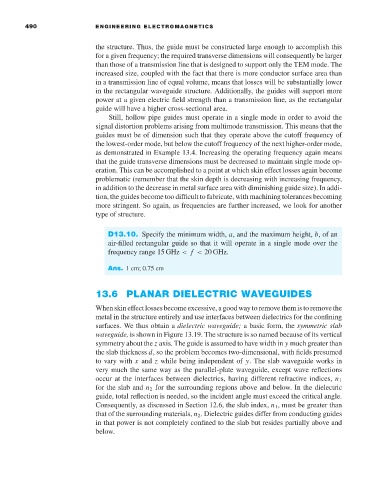Page 508 - Engineering Electromagnetics, 8th Edition
P. 508
490 ENGINEERING ELECTROMAGNETICS
the structure. Thus, the guide must be constructed large enough to accomplish this
for a given frequency; the required transverse dimensions will consequently be larger
than those of a transmission line that is designed to support only the TEM mode. The
increased size, coupled with the fact that there is more conductor surface area than
in a transmission line of equal volume, means that losses will be substantially lower
in the rectangular waveguide structure. Additionally, the guides will support more
power at a given electric field strength than a transmission line, as the rectangular
guide will have a higher cross-sectional area.
Still, hollow pipe guides must operate in a single mode in order to avoid the
signal distortion problems arising from multimode transmission. This means that the
guides must be of dimension such that they operate above the cutoff frequency of
the lowest-order mode, but below the cutoff frequency of the next higher-order mode,
as demonstrated in Example 13.4. Increasing the operating frequency again means
that the guide transverse dimensions must be decreased to maintain single mode op-
eration. This can be accomplished to a point at which skin effect losses again become
problematic (remember that the skin depth is decreasing with increasing frequency,
in addition to the decrease in metal surface area with diminishing guide size). In addi-
tion, the guides become too difficult to fabricate, with machining tolerances becoming
more stringent. So again, as frequencies are further increased, we look for another
type of structure.
D13.10. Specify the minimum width, a, and the maximum height, b,ofan
air-filled rectangular guide so that it will operate in a single mode over the
frequency range 15 GHz < f < 20 GHz.
Ans. 1 cm; 0.75 cm
13.6 PLANAR DIELECTRIC WAVEGUIDES
When skin effect losses become excessive, a good way to remove them is to remove the
metal in the structure entirely and use interfaces between dielectrics for the confining
surfaces. We thus obtain a dielectric waveguide; a basic form, the symmetric slab
waveguide, is shown in Figure 13.19. The structure is so named because of its vertical
symmetry about the z axis. The guide is assumed to have width in y much greater than
the slab thickness d,so the problem becomes two-dimensional, with fields presumed
to vary with x and z while being independent of y. The slab waveguide works in
very much the same way as the parallel-plate waveguide, except wave reflections
occur at the interfaces between dielectrics, having different refractive indices, n 1
for the slab and n 2 for the surrounding regions above and below. In the dielectric
guide, total reflection is needed, so the incident angle must exceed the critical angle.
Consequently, as discussed in Section 12.6, the slab index, n 1 , must be greater than
that of the surrounding materials, n 2 . Dielectric guides differ from conducting guides
in that power is not completely confined to the slab but resides partially above and
below.

